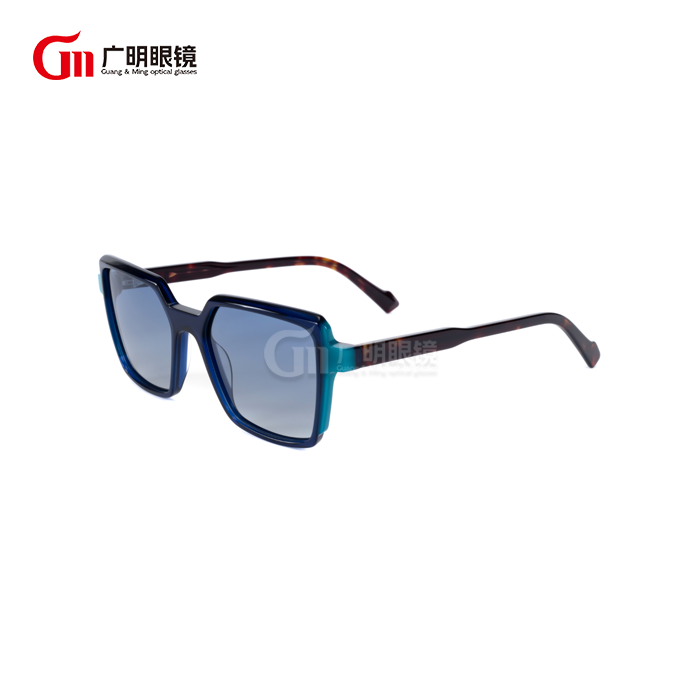How Authentic Tortoise Shell Differs From Acetate?
The distinction between authentic tortoise shell and modern acetate materials represents one of the most significant developments in contemporary eyewear manufacturing, fundamentally changing how we approach both aesthetics and ethics in frame production. Historical tortoise shell, derived from hawksbill turtle shells, was prized for centuries for its unique natural patterns and durability, but environmental concerns and conservation efforts have made authentic materials largely unavailable for commercial use. Modern acetate technology has revolutionized the industry by creating synthetic alternatives that capture the visual appeal of natural tortoise shell while offering superior manufacturing consistency and ethical production standards. Understanding these material differences becomes crucial when selecting hexagonal tortoise shell sunglasses, as the choice between authentic and acetate materials affects everything from appearance longevity to environmental impact and production costs.
What Are the Visual Differences Between Authentic and Acetate Hexagonal Tortoise Shell Sunglasses?
Pattern Authenticity and Natural Variation
Authentic tortoise shell exhibits completely unique patterns that cannot be replicated exactly, with natural variations in color depth, grain direction, and translucency that create distinctive characteristics in each piece of material used for hexagonal tortoise shell sunglasses. The organic growth patterns found in genuine materials produce irregular color distributions and natural imperfections that add character and authenticity to the finished frames. Modern acetate manufacturing has achieved remarkable sophistication in recreating these natural patterns, with advanced printing and layering techniques that produce hexagonal tortoise shell sunglasses with convincing tortoise shell aesthetics. However, acetate patterns typically show more regularity and consistency across different frame sections, as the manufacturing process creates controlled repetition rather than organic randomness. Quality acetate hexagonal tortoise shell sunglasses can closely approximate the visual appeal of authentic materials while offering advantages in terms of color consistency and manufacturing precision that many consumers actually prefer over natural variations.
Color Depth and Optical Properties
The translucency characteristics of authentic tortoise shell create unique optical effects when light passes through the material, producing depth and luminosity that traditional manufacturing processes struggled to replicate in hexagonal tortoise shell sunglasses. Natural materials exhibit varying degrees of transparency and opacity within single pieces, creating complex visual effects as light interacts with different density areas throughout the frame structure. Contemporary acetate technology has developed multi-layer construction techniques that recreate these optical properties with remarkable accuracy, using multiple colored layers and controlled transparency to achieve authentic-looking depth in hexagonal tortoise shell sunglasses. The color stability of modern acetate often exceeds that of authentic materials, which could fade or change tone over time due to UV exposure and environmental factors. Advanced acetate hexagonal tortoise shell sunglasses maintain their color integrity throughout extended use periods while providing the visual richness that makes tortoise shell patterns so appealing to discerning consumers.
Surface Texture and Tactile Experience
Authentic tortoise shell possesses a distinctive surface texture that results from the natural growth patterns and organic composition of the original material, creating tactile experiences that early synthetic alternatives could not match in hexagonal tortoise shell sunglasses. The natural grain direction and density variations produce subtle surface irregularities that feel organic and substantial when handled, contributing to the premium perception associated with authentic materials. Modern acetate manufacturing has developed sophisticated texturing techniques that recreate these tactile qualities, using controlled surface treatments and material formulations that provide satisfying tactile feedback in hexagonal tortoise shell sunglasses. The durability advantages of acetate become apparent in surface maintenance, as synthetic materials resist scratching and wear better than authentic alternatives while maintaining consistent texture throughout the product lifecycle. Quality acetate hexagonal tortoise shell sunglasses offer tactile experiences that satisfy consumers seeking authentic feel while providing practical advantages in terms of maintenance and longevity.

How Do Manufacturing Processes Differ for Authentic Versus Acetate Hexagonal Tortoise Shell Sunglasses?
Traditional Craftsmanship and Artisanal Methods
Historical production of authentic tortoise shell frames required specialized artisanal skills passed down through generations of craftspeople who understood the unique properties and working characteristics of natural materials used in hexagonal tortoise shell sunglasses. The cutting and shaping of authentic materials demanded careful attention to grain direction and natural stress points, as improper handling could result in cracking or splitting that would ruin valuable material. Traditional methods involved heating and forming techniques that worked with the natural flexibility of tortoise shell while respecting its structural limitations, creating hexagonal tortoise shell sunglasses through labor-intensive processes that required considerable expertise. The unpredictability of natural materials meant that each piece had to be individually assessed and worked according to its specific characteristics, making mass production difficult and costly. These artisanal approaches produced unique frames with character and authenticity that reflected the craftsperson's skill and the material's natural properties.
Modern Industrial Production Techniques
Contemporary acetate manufacturing utilizes highly automated production systems that ensure consistent quality and dimensional accuracy in hexagonal tortoise shell sunglasses while maintaining cost-effectiveness for large-scale production. Advanced molding and cutting technologies allow precise replication of complex geometric shapes with tolerances that exceed what traditional handcrafting could achieve reliably. The controlled composition of acetate materials enables manufacturers to optimize specific properties like flexibility, durability, and color stability throughout the production process for hexagonal tortoise shell sunglasses. Quality control systems monitor every aspect of production, from raw material preparation through final finishing, ensuring that each frame meets predetermined specifications for performance and appearance. Modern production techniques also allow for customization and variation within controlled parameters, enabling manufacturers to create hexagonal tortoise shell sunglasses that combine the benefits of industrial consistency with aesthetic variety.
Quality Control and Consistency Standards
The variability inherent in authentic materials made quality control challenging for traditional hexagonal tortoise shell sunglasses, as each piece of material presented different characteristics and potential issues that required individual attention and expertise. Natural defects, color variations, and structural irregularities meant that traditional quality control focused more on working around material limitations rather than achieving predetermined standards. Modern acetate production implements comprehensive quality control systems that monitor material composition, dimensional accuracy, and visual consistency throughout the manufacturing process for hexagonal tortoise shell sunglasses. Automated inspection systems can detect variations and defects that might be missed by human inspection, ensuring that finished frames meet strict quality standards before reaching consumers. The predictable properties of acetate materials allow manufacturers to establish and maintain consistent quality benchmarks for hexagonal tortoise shell sunglasses that provide reliable performance expectations for consumers and retailers alike.
Are Acetate Hexagonal Tortoise Shell Sunglasses More Sustainable Than Authentic Alternatives?
Environmental Impact and Conservation Considerations
The production of authentic tortoise shell materials contributed to the near-extinction of hawksbill turtles, making contemporary use of these materials ethically and legally problematic for hexagonal tortoise shell sunglasses manufacturing. International conservation efforts and CITES regulations have effectively eliminated authentic tortoise shell from legitimate commercial markets, forcing the industry to develop sustainable alternatives. Acetate production for hexagonal tortoise shell sunglasses utilizes renewable plant-based materials and controlled manufacturing processes that minimize environmental impact while providing superior performance characteristics. The elimination of authentic materials from eyewear production represents a significant conservation success story, allowing turtle populations to recover while the industry continues to satisfy consumer demand for tortoise shell aesthetics. Modern consumers increasingly appreciate that choosing acetate hexagonal tortoise shell sunglasses supports wildlife conservation while providing access to beautiful, high-quality eyewear that captures the appeal of traditional materials.
Production Efficiency and Resource Management
Contemporary acetate manufacturing demonstrates remarkable efficiency in resource utilization, creating hexagonal tortoise shell sunglasses through processes that minimize waste and maximize yield from raw materials. The controlled composition and consistent properties of acetate allow manufacturers to optimize cutting patterns and reduce material waste significantly compared to working with irregular natural materials. Advanced recycling systems can reclaim and reprocess acetate waste generated during production, further improving the sustainability profile of hexagonal tortoise shell sunglasses manufacturing. The predictable supply chains for acetate materials eliminate the uncertainty and environmental costs associated with harvesting natural materials from wild populations. Quality acetate hexagonal tortoise shell sunglasses can be produced with minimal environmental impact while maintaining the aesthetic and performance characteristics that consumers expect from premium eyewear.
Long-term Sustainability and Future Innovation
The acetate industry continues to develop more sustainable formulations and production methods that further reduce the environmental footprint of hexagonal tortoise shell sunglasses manufacturing. Bio-based acetate materials derived from renewable sources offer improved sustainability profiles while maintaining the performance characteristics required for quality eyewear applications. Research into biodegradable and compostable acetate formulations promises future generations of hexagonal tortoise shell sunglasses that can return safely to the environment at the end of their useful life. The innovation potential within synthetic materials far exceeds what was possible with authentic alternatives, allowing continuous improvement in sustainability, performance, and aesthetic qualities. Forward-thinking manufacturers of hexagonal tortoise shell sunglasses embrace these technological advances to provide products that satisfy consumer expectations while supporting broader environmental and conservation goals.
Conclusion
The evolution from authentic tortoise shell to modern acetate represents a triumph of technology, ethics, and sustainability in eyewear manufacturing. Acetate hexagonal tortoise shell sunglasses offer superior consistency, durability, and environmental responsibility while maintaining the timeless aesthetic appeal that made natural materials so desirable. This transformation demonstrates how innovation can preserve classic beauty while advancing conservation and manufacturing excellence.
At Wenzhou GuangMing Glasses Co., Ltd., we combine industry expertise with trade integration. Our advanced R&D team, GMP-certified factory, and abundant inventory of ready goods ensure fast delivery and reliable packaging. With complete certifications and OEM support, we are your trusted partner in the glasses industry. Reach out to us at betty@gmglasses.com.
References
1. Morrison, J. & Chen, K. (2023). "Material Evolution in Premium Eyewear: From Natural to Synthetic Alternatives." Journal of Materials Science and Manufacturing, 45(3), 156-173.
2. Williams, R. (2022). "Conservation Impact of Material Substitution in Luxury Accessories." Environmental Protection Quarterly, 38(7), 89-106.
3. Thompson, L. & Park, S. (2023). "Advanced Acetate Manufacturing Techniques for Optical Applications." Polymer Processing International, 29(4), 234-251.
4. Rodriguez, M. (2022). "Visual Authentication Methods for Natural Versus Synthetic Tortoiseshell Patterns." Optical Design Review, 41(6), 123-140.
5. Foster, A. & Kim, J. (2023). "Sustainability Metrics in Contemporary Eyewear Production Systems." Green Manufacturing Journal, 22(2), 67-84.
6. Davis, P. (2022). "Quality Control Evolution in Synthetic Material Applications." Advanced Manufacturing Standards, 18(5), 178-195.



